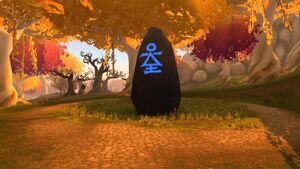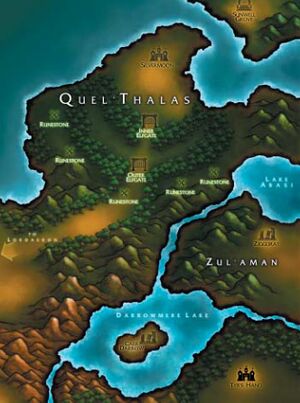Runestone
- Not to be confused with Runestone (Island Expeditions) or Runestone (Stormheim).
Runestones are large blocks of rock carved with powerful magical runes. The high elves of Quel'Thalas built several runestones along their borders.
History
Creation
Shortly after the founding of Quel'Thalas, many of the high elves grew wary that their use of arcane magic might once again draw the Burning Legion to Azeroth, as had happened during the War of the Ancients. Dath'Remar Sunstrider sent his most powerful arcanists to find a solution. The arcanists decided to create a protective barrier named Ban'dinoriel ("the Gatekeeper") around the land, which would prevent others from detecting their magic, frighten away their superstitious Amani rivals,[1][2][3] and weaken the magic of all non-elves within it.[4][5] Over several decades, the arcanists built a series of monolithic Runestones around the borders of Quel'Thalas to mark the boundaries of the barrier.[1][2] The Runestones were powered by the Sunwell[6] and linked to the mother tree Thas'alah, tying the power of the tree's nature magic to the elves' arcane spells.[3]
Second War
- Main article: Runestone (Warcraft II)
Original Warcraft II: Tides of Darkness description of the runestone at Caer Darrow: The runestone was an ancient monolith erected by the elven druids and inscribed with powerful runes of protection and warding. The runestone, seized by Gul'dan and his ogres, was eventually hewn into slates that were then used to construct the Altars of Storms. The elves, knowing that their sacred artifact had been defiled to create the ogre-magi, had sworn to destroy all of the unholy Altars across the kingdom.[7]
The original story about elven druids was later changed so that it was mages who had placed them instead.[2] The description was also broadened when it was said that diabolical orcish necromancers had found a way to dismantle and draw energy from several runestones instead of just Gul'dan and one runestone.[8]
Gul'dan himself speculated that the high elves had used enslaved trolls to physically move the stones into place, similarly to how he used ogre slaves to destroy them and build the altars, but this remains unconfirmed.[9]
During the burning of Quel'Thalas, Gul'dan intended to use the power of the Altars of Storms to break through Ban'dinoriel's protection. As the Altars were crafted from the elves' own runestones, which were originally powered by the Sunwell, the warlock thought to use that link in reverse, sending his own magic into their power source and either destroying it or wresting it away from them.[6]
Though it was never mentioned again and probably retconned, a Dalaran expedition sent to the Tomb of Sargeras during the invasion of Draenor used two runestones along its entrance to protect it from demons.[10]
Third War
Five runestones were shown on a map of Quel'Thalas in the Warcraft III manual but were later omitted in the game's loading screens.
The Burning Crusade
The remaining runestones are used to protect Quel'Thalas against the Scourge. Most of them were destroyed or lost after the attack on the Sunwell.[11] Runewarden Deryan re-energizes and maintains the remaining runestones in Quel'Thalas.[12]
Known
Quel'Thalas
- Runestone Falithas, Eversong Woods (functional)
- Runestone Shan'dor, Eversong Woods (offline, but able to be reactivated)
- Runestone in the Scorched Grove, Eversong Woods (destroyed)
- Mentioned fourth runestone[citation needed]
Other
- Runestone at Caer Darrow (destroyed, used to create Altars of Storms)
- Ancient Vortex Runestone in Desolace
Runestones as items
These items appear to have no relation to the elven runestones described above.
 [Amethyst Runestone] from the Pillar of Amethyst in Badlands
[Amethyst Runestone] from the Pillar of Amethyst in Badlands [Diamond Runestone] from the Pillar of Diamond in Badlands
[Diamond Runestone] from the Pillar of Diamond in Badlands [Opal Runestone] from the Pillar of Opal in Badlands
[Opal Runestone] from the Pillar of Opal in Badlands
In the RPG
When the high elves founded Quel'Thalas, they erected monolithic runestones to mark their new kingdom's borders. These enchanted monuments created a magical barrier that prevented the savage forest trolls from penetrating the elven lands. The barrier was not used for millennia, but the runestones, untouched by fire and blade, remained.[13]
Notes
- Different kind of runestones are used by vrykul to summon elementals.[14]
- The
 [Lightbound Runestone] are pieces of pylons used by the Army of the Light to transport their troops to distant worlds.
[Lightbound Runestone] are pieces of pylons used by the Army of the Light to transport their troops to distant worlds.
References
- ^ a b
 [The Founding of Quel'Thalas]
[The Founding of Quel'Thalas]
- ^ a b c World of Warcraft: Chronicle Volume 1, pg. 121
- ^ a b Tales of the Hunt: Thas'dorah, Legacy of the Windrunners
- ^ Tides of Darkness, chapter 11
- ^ Blood of the Highborne, chapter 1
- ^ a b Tides of Darkness, chapter 15
- ^ Warcraft II: Tides of Darkness manual, Places of Mystery, The Runestone at Caer Darrow
- ^ Blood of the Highborne, pg. 36
- ^ Tides of Darkness, pg. 194
- ^ The Tomb of Sargeras (WC2x Orc)
- ^
 [1-30] Runewarden Deryan
[1-30] Runewarden Deryan
- ^
 [1-30] Powering our Defenses
[1-30] Powering our Defenses
- ^ Lands of Conflict, pg. 112
- ^
 The Rocks Below
The Rocks Below
es:Piedra rúnica



